Exotic
Cryptophlebia ombrodelta (Lower) (Tortricidae: Olethreutinae: Grapholitini)
Common names: litchi fruit moth, macadamia nut borer
Synonyms: carpophaga (Cryptophlebia)
FWLFWL:
forewing length; the distance from the base of the forewing to the apex, including fringe : 6.4-8.4 mm (males); 6.4-11.5 mm (females)
: 6.4-8.4 mm (males); 6.4-11.5 mm (females)
Adults are brown to reddish brown with a dark-brown pretornal spot that is more pronounced in females. Males have sex scales on the hindwing, hind tibia, and abdomen. Males lack a forewing costal foldforewing costal fold:
a flap or fold at the base of the forewing that contains specialized sex scales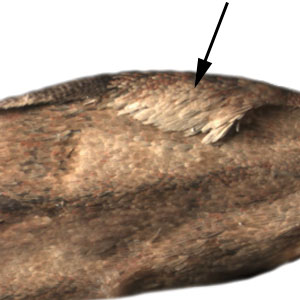 .
.
Male genitalia are characterized by swollen valvaevalva:
an appendage flanking the intromittent organ that is used to clasp the female during copulation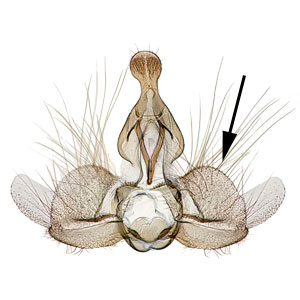 with three large spines on the cuculluscucullus:
with three large spines on the cuculluscucullus:
the distal portion of the male valva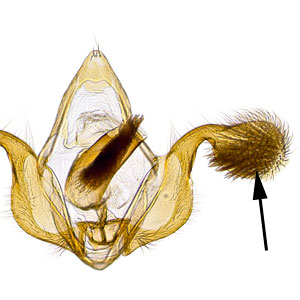 . Female genitalia are characterized by a narrow, V-shaped sterigmasterigma:
. Female genitalia are characterized by a narrow, V-shaped sterigmasterigma:
the sclerotized region surrounding the female ostium bursae 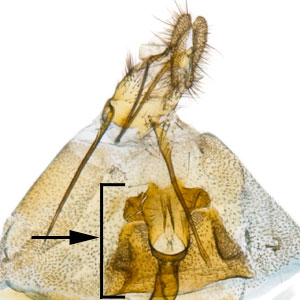 that is separate from the posteriorposterior:
that is separate from the posteriorposterior:
after, to the rear, toward anal end 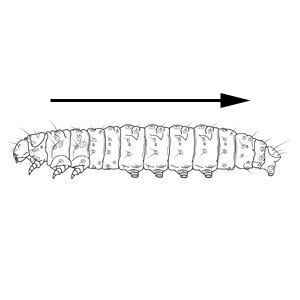 margin of sternum VII and two signasignum:
margin of sternum VII and two signasignum:
a sclerotized projection or patch on the interior of the corpus bursae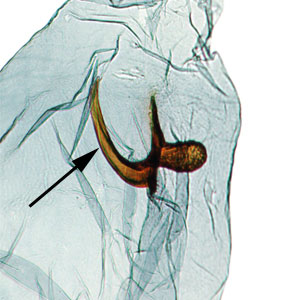 in the corpus bursaecorpus bursae:
in the corpus bursaecorpus bursae:
a dilated membranous sac at the anterior end of the bursa copulatrix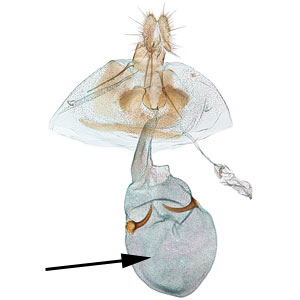 .
.
The following account is summarized from MacKay (1959)MacKay (1959):
MacKay, M. R. 1959. Larvae of the North American Olethreutidae (Lepidoptera). Canadian Entomologist, Supplement 10: 1-338. and Zimmerman (1978)Zimmerman (1978):
Zimmerman, E. C. 1978. Insects of Hawaii, Volume 9, Microlepidoptera, Part 1. University of Hawaii Press, Honolulu, Hawaii. 881 pp..
Larvae are very similar to those of C. illepida except that some specimens of C. ombrodelta possess "indications of an anal fork". Other diagnostic features of Cryptophlebia larvae include: T1 prespiracular pinaculumpinaculum:
flattened sclerotized plates on a caterpillar that bear the setae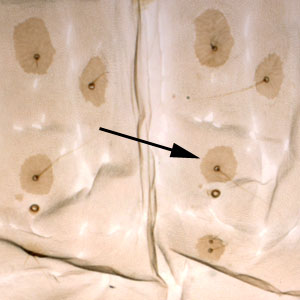 extends below the spiracle; SV counts on A1,2,7,8,9 as 3:3:2(3):2(1):1; SV seta on A8 and A9 bi setosesetose:
extends below the spiracle; SV counts on A1,2,7,8,9 as 3:3:2(3):2(1):1; SV seta on A8 and A9 bi setosesetose:
covered with setae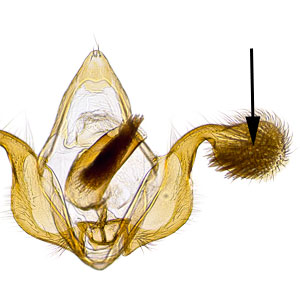 ; spiracle on A8 near posteriorposterior:
; spiracle on A8 near posteriorposterior:
after, to the rear, toward anal end  margin of segment and displaced dorsally; L group on A9 usually trisetose (occasionally bisetose); D1 and SD1 setae on same pinaculumpinaculum:
margin of segment and displaced dorsally; L group on A9 usually trisetose (occasionally bisetose); D1 and SD1 setae on same pinaculumpinaculum:
flattened sclerotized plates on a caterpillar that bear the setae on A9; and D2 setae on shared saddlesaddle:
on A9; and D2 setae on shared saddlesaddle:
in reference to the D2 pinacula on larval segment A9; both setae are on a single, fused pinaculum in the mid-dorsal region of the segment  pinaculumpinaculum:
pinaculumpinaculum:
flattened sclerotized plates on a caterpillar that bear the setae on A9.
on A9.
Adults of most Cryptophlebia species are superficially similar and are often mixed in museum collections. A genitalic dissection is usually necessary to confirm identity. The three species treated here, C. illepida, C. ombrodelta, and C. peltastica, can be separated by genitalic characters and geographic distribution, as outlined in the following table:
| Cryptophlebia species | Male valvavalva: an appendage flanking the intromittent organ that is used to clasp the female during copulation  |
Female sterigmasterigma: the sclerotized region surrounding the female ostium bursae  |
Distribution |
|---|---|---|---|
| illepida | Two large spines, multiple rows of marginal spines | Wide, V-shaped | Hawaii |
| ombrodelta | Three large spines | Narrow, V-shaped, separate | Australia, Guam, Japan, India, Southeast Asia, Hawaii (int.) |
| peltastica | Three large spines, margin densely setosesetose: covered with setae  |
Narrow, ovate, deeply inset | Africa, Seychelles, Mauritius, Guam (int.) |
Both C. illepida and C. ombrodelta occur in Hawaii; the former is assumed to be native as it is has not been found in any other locality, and the latter has been introduced. In addition to the genitalic differences listed above, adults of these two species can be separated by a character on the male hind tibia: in C. ombrodelta there is an ovate bare patch that is absent in C. illepida.
The biology of C. ombrodelta is similar to that of C. illepida. Females lay eggs on the fruits or pods of the host plant. Larvae bore into the fruit or pod and feed on the seeds. Pupation occurs in the fruit or pod or in the ground. Development is continuous and adults are present year-round.
Cryptophlebia ombrodelta is an important pest of macadamia, litchi, and longan fruit in Asia, Australia, and Hawaii. Larvae are moderately polyphagous and have been recorded feeding on plants in several families.
| Host plant | Host plant family | Reference(s) |
| Cocos nucifera | Arecaceae | Clarke 1976Clarke 1976: Clarke, J. F. G. 1976. Microlepidoptera: Tortricoidea. Insects of Micronesia. 9: 1-144.; Zimmerman 1978Zimmerman 1978: Zimmerman, E. C. 1978. Insects of Hawaii, Volume 9, Microlepidoptera, Part 1. University of Hawaii Press, Honolulu, Hawaii. 881 pp. |
| Nephelium lappaceum | Euphorbiaceae | McQuate et al. 2000McQuate et al. 2000: McQuate, G. T., Folett, P. A., Yoshimoto, J. M. 2000. Field infestation of rambutan fruits by internal-feeding pests in Hawaii. Journal of Economic Entomology. 93: 846-851. |
| [unspecified] | Fabaceae | Diakonoff 1982Diakonoff 1982: Diakonoff, A. 1982. On a collection of some families of Mircolepidoptera from Sri Lanka (Ceylon). Zooloigische Verhandelingen, Leiden 193. 124 pp. + figs.; Chang & Chen 1989 |
| Acacia farnesiana | Fabaceae | Simon Thomas 1958Simon Thomas 1958: Simon Thomas, R. T. 1958. Insects bred from cultivated and ornamental plants in Netherlands New Guinea. Tijdschrift voor Entomologie. 101: 223-228.; Clarke 1976Clarke 1976: Clarke, J. F. G. 1976. Microlepidoptera: Tortricoidea. Insects of Micronesia. 9: 1-144.; Zimmerman 1978Zimmerman 1978: Zimmerman, E. C. 1978. Insects of Hawaii, Volume 9, Microlepidoptera, Part 1. University of Hawaii Press, Honolulu, Hawaii. 881 pp. |
| Acacia nilotica | Fabaceae | Diakonoff 1968a |
| Acacia sp. | Fabaceae | Bradley 1953aBradley 1953a: Bradley, J. D. 1953. Some important species of the genus Cryptophlebia Walsingham, 1899, with descriptions of three new species (Lepidoptera: Olethreutidae). Bulletin of Entomological Research. 43: 679-689.; Diakonoff 1968a; Clarke 1976Clarke 1976: Clarke, J. F. G. 1976. Microlepidoptera: Tortricoidea. Insects of Micronesia. 9: 1-144.; Horak |
| Adenanthera pavonina | Fabaceae | Bradley 1953aBradley 1953a: Bradley, J. D. 1953. Some important species of the genus Cryptophlebia Walsingham, 1899, with descriptions of three new species (Lepidoptera: Olethreutidae). Bulletin of Entomological Research. 43: 679-689.; Diakonoff 1968a; Clarke 1976Clarke 1976: Clarke, J. F. G. 1976. Microlepidoptera: Tortricoidea. Insects of Micronesia. 9: 1-144.; Zimmerman 1978Zimmerman 1978: Zimmerman, E. C. 1978. Insects of Hawaii, Volume 9, Microlepidoptera, Part 1. University of Hawaii Press, Honolulu, Hawaii. 881 pp.; Horak 2006Horak 2006: Horak, M. 2006. Olethreutine moths of Australia (Lepidoptera: Tortricidae). Monographs on Australian Lepidoptera, Vol. 10. 522 pp. |
| Bauhinia hirsuta | Fabaceae | Clarke 1976Clarke 1976: Clarke, J. F. G. 1976. Microlepidoptera: Tortricoidea. Insects of Micronesia. 9: 1-144. |
| Bauhinia malabarica | Fabaceae | Clarke 1976Clarke 1976: Clarke, J. F. G. 1976. Microlepidoptera: Tortricoidea. Insects of Micronesia. 9: 1-144. |
| Bauhinia purpurea | Fabaceae | Bradley 1953aBradley 1953a: Bradley, J. D. 1953. Some important species of the genus Cryptophlebia Walsingham, 1899, with descriptions of three new species (Lepidoptera: Olethreutidae). Bulletin of Entomological Research. 43: 679-689.; Diakonoff 1968a; Clarke 1976Clarke 1976: Clarke, J. F. G. 1976. Microlepidoptera: Tortricoidea. Insects of Micronesia. 9: 1-144. |
| Bauhinia sp. | Fabaceae | Zimmermann 1978; Dugdale et al. 2005Dugdale et al. 2005: Dugdale, J. S., Gleeson, D., Clunie, L. H., Holder, P. W. 2005. A diagnostic guide to Tortricidae encountered in field surveys and quarantine inspections in New Zealand: Morphological and molecular characters. National Plant Pest Reference Laboratory. 161 pp.; Horak 2006Horak 2006: Horak, M. 2006. Olethreutine moths of Australia (Lepidoptera: Tortricidae). Monographs on Australian Lepidoptera, Vol. 10. 522 pp. |
| Caesalpinia decapetala | Fabaceae | Komai 1999Komai 1999: Komai, F. 1999. A taxonomic review of the genus Grapholita and allied genera (Lepidoptera: Tortricidae) in the Palaearctic region. Entomologica Scandinavica Supplement 55. 226 pp. |
| Caesalpinia pulcherrima | Fabaceae | Zimmerman 1978Zimmerman 1978: Zimmerman, E. C. 1978. Insects of Hawaii, Volume 9, Microlepidoptera, Part 1. University of Hawaii Press, Honolulu, Hawaii. 881 pp. |
| Caesalpinia sappan | Fabaceae | Clarke 1976Clarke 1976: Clarke, J. F. G. 1976. Microlepidoptera: Tortricoidea. Insects of Micronesia. 9: 1-144. |
| Cassia fistula | Fabaceae | Bradley 1953aBradley 1953a: Bradley, J. D. 1953. Some important species of the genus Cryptophlebia Walsingham, 1899, with descriptions of three new species (Lepidoptera: Olethreutidae). Bulletin of Entomological Research. 43: 679-689.; Diakonoff 1968a; Clarke 1976Clarke 1976: Clarke, J. F. G. 1976. Microlepidoptera: Tortricoidea. Insects of Micronesia. 9: 1-144. |
| Cassia javanica x fistula | Fabaceae | Zimmerman 1978Zimmerman 1978: Zimmerman, E. C. 1978. Insects of Hawaii, Volume 9, Microlepidoptera, Part 1. University of Hawaii Press, Honolulu, Hawaii. 881 pp. |
| Cassia sp. | Fabaceae | Horak 2006Horak 2006: Horak, M. 2006. Olethreutine moths of Australia (Lepidoptera: Tortricidae). Monographs on Australian Lepidoptera, Vol. 10. 522 pp. |
| Delonix sp. | Fabaceae | Horak 2006Horak 2006: Horak, M. 2006. Olethreutine moths of Australia (Lepidoptera: Tortricidae). Monographs on Australian Lepidoptera, Vol. 10. 522 pp. |
| Delonix regia | Fabaceae | Zimmerman 1978Zimmerman 1978: Zimmerman, E. C. 1978. Insects of Hawaii, Volume 9, Microlepidoptera, Part 1. University of Hawaii Press, Honolulu, Hawaii. 881 pp. |
| Glycine max | Fabaceae | Simon Thomas 1958Simon Thomas 1958: Simon Thomas, R. T. 1958. Insects bred from cultivated and ornamental plants in Netherlands New Guinea. Tijdschrift voor Entomologie. 101: 223-228., 1962 |
| Indigofera suffruticosa | Fabaceae | Zimmerman 1978Zimmerman 1978: Zimmerman, E. C. 1978. Insects of Hawaii, Volume 9, Microlepidoptera, Part 1. University of Hawaii Press, Honolulu, Hawaii. 881 pp. |
| Parkinsonia aculeata | Fabaceae | Bradley 1953aBradley 1953a: Bradley, J. D. 1953. Some important species of the genus Cryptophlebia Walsingham, 1899, with descriptions of three new species (Lepidoptera: Olethreutidae). Bulletin of Entomological Research. 43: 679-689.; Diakonoff 1968a; Clarke 1976Clarke 1976: Clarke, J. F. G. 1976. Microlepidoptera: Tortricoidea. Insects of Micronesia. 9: 1-144. |
View full screen host table here
Cryptophlebia ombrodelta is recorded from Australia, Guam, India, Japan, Java, Philippines, Sri Lanka, Taiwan, and Thailand. It has been introduced into Hawaii.